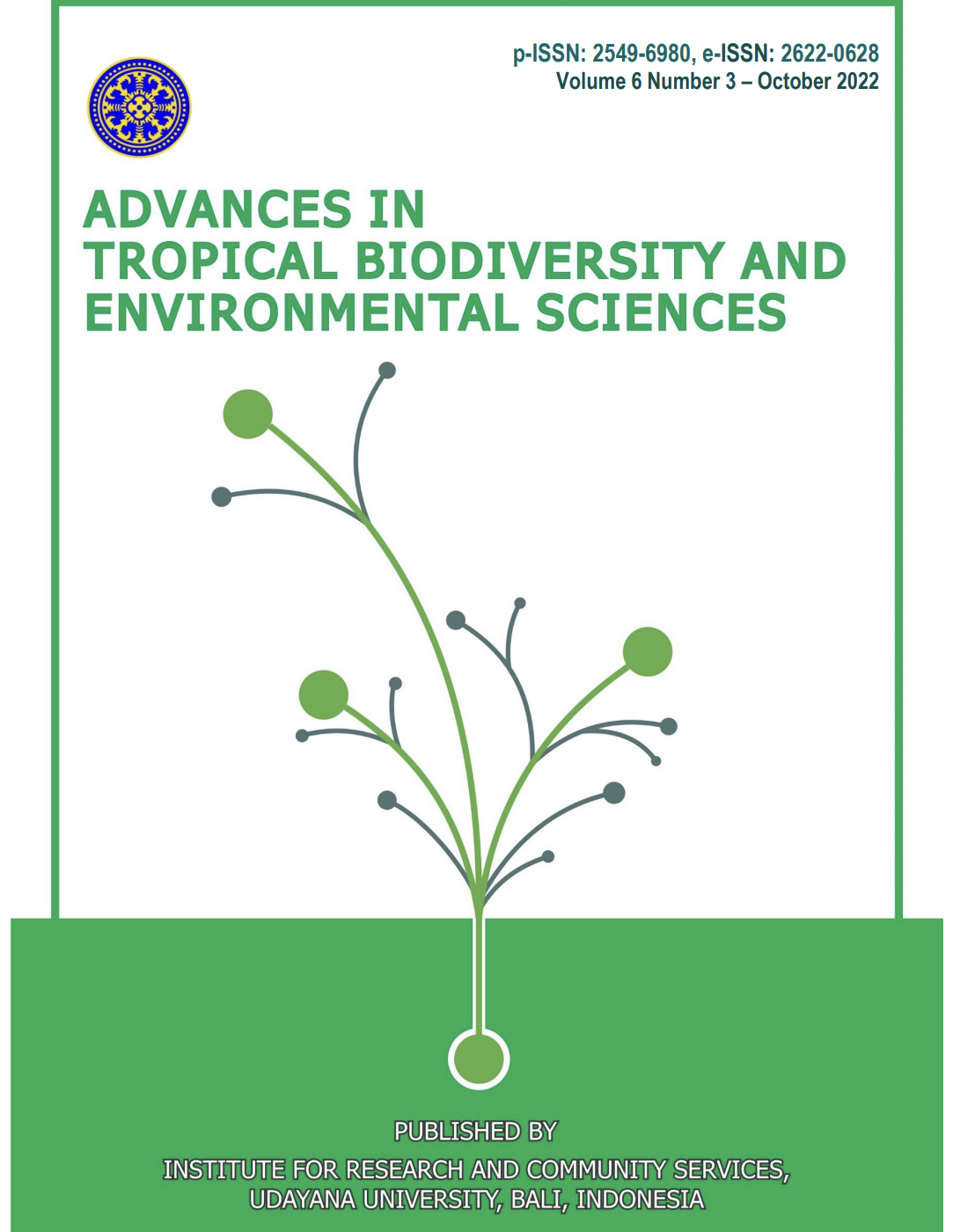The Effect of Reduce Salinity on Behavior and Stress Response in Vannamei Shrimp (Litopenaeus vannamei)
Abstract
One of the parameters that play an important role in the success of vannamei shrimp cultivation is salinity. This study aims to determine the effect of decreasing salinity on the behavior and stress response of vannamei shrimp. The test animals used were vannamei shrimp, which were in logs with an average weight of 4.6 – 6.3g. This study used a completely randomized design (CRD) with different salinity reduction treatments in each maintenance medium, namely Treatment A without decreasing salinity, Treatment B decreasing salinity 2 ppt per 6 hours for 24 hours, Treatment C decreasing salinity 2 ppt per 4 hours for 24 hours, Treatment D decreased salinity 2 ppt per 2 hours for 24 hours, each treatment was repeated 3 times. Blood glucose was measured after the decrease in salinity and on the last day of the study. Blood glucose collection was carried out at the fifth swimming leg on white shrimp using a 1 ml syringe that had been rinsed using Na Citrate with the aim that the blood glucose taken did not clot quickly. The results showed a decrease in salinity caused by shrimp stress. The concentration of vannamei shrimp blood glucose increased (13.66 – 52.37mg/dl). Treatment D was the best glucose concentration to suppress blood glucose concentrations (13.66mg/dl). Based on the data analysis of blood glucose concentration (p<0.05) it continued with the real difference test. Vannamei shrimp behavior during salinity reduction showed a response that was not different from all treatments. Salinity 6 ppt is good salinity in the process of suppressing blood glucose concentrations when changes in water salinity occur.
Downloads
References
[2] Anita, A. W., M. Agus., Y. T. Mardiana. 2017. Effect of Salinity Differences on Growth and Survival of Vannamei Shrimp (Litopenaeus vannamei) PL 13. Aquaculture Study Program, Faculty of Marine and Fisheries: Pekalongan University. Aquatic Pena Journal. 16 (1):13-14.
[3] Barton BA. 2002. Stress in fishes: A diversity of responses with particular reference to changes ini circulating corticostreroids. Integrative and Comparative Biology 42: 517-525.
[4] Begg, K., N. W. Pankhurst. 2004. Endocrine and Metabolic Responses to Stress in a Laboratory Population of the Tropical Damselfish. Acanthochromis Polyacanthus. Jurnal Fish Biologi 64 : 133-145.
[5] Bonga, S. E. W. 1997. The stress response in fish. Physiological Reviews 77 (3): 591-625.
[6] Chung, J. S., N. Zmora., H. Katayama., N. Tsutsui. 2010. Crustacean hyperglycemic hormone (CHH.) neuropeptides family : Functions, titer, and binding to target tissues. General and Comparative Endocrinology, 166 : 447-454.
[7] Dahlan, J., M. Hamzah., A. Kurnia. 2017. Growth of Vannamei Shrimp (Litopenaeus vannamei) Cultured in Biofloc System with Addition of Probiotics. Fisheries Science Study Program, Faculty of Fisheries and Marine Sciences, Halu Oleo University, Kendari, Indonesia. Journal of Fishery Science and Innovation Journal of Fishery Science and Innovation.1(2): 1-9.
[8] Fitriani, N. N., Z. Abidin., M. Marzuki. 2018. Growth and Survival of Vannamei Shrimp (Litopenaeus vannamei) in Different Salinity Maintenance. Scientific Journal of Fisheries and Marine Affairs. Mataram University.
[9] Hadi, F. R., I. Riyantini., U. Subhan., Y. N. Ihsan,. 2018. Effect of Low Salinity Stress in Waters on Adaptability of Vannamei Shrimp (Litopenaeus vannamei). Padjadjaran University. Journal of Fisheries and Marine. 9 (2) : 72-79.
[10] Kristiany, M. G., E. Marlina. 2014. Statistics for Aquaculture with Microsoft Excel Aquaculture Approach.
[11] Mazeaud, M. M., F. Mazeaud. 1981. Andrenergic responses to stress in fish, In A.D. Pickering. (Ed.). Stress and Fish. Academic Press, London., 49-75.
[12] McEwen, B. S. 1998. Protective and Damaging Effects of Stress Mediators. N Engl J Med., 338: 171-179.
[13]. Nasichah Z, P. Widjanarko., A. Kurniawan., D. Arfiati. 2016. Analysis of Blood Glucose Levels of Tawes Fish (Barbonymus Gonionotus) from Rolak Songo Dam Downstream of Brantas River. Water Resources Management Study Program, Faculty of Fisheries and Marine Science, Universitas Brawijaya. Proceedings of the National Marine Seminar, Trunojoyo University, Madura. Halaman 328 -333.
[14] Oktari, A. D. 2017. Analysis of Glucose Levels in Windu Shrimp (Penaeus Monodon) In Pond With Immuno-Probiocirculation (Si-Pbr) System. Thesis thesis, Universitas Airlangga.
[15] Pamungkas, W. 2012. Osmoregulation Activity, Growth Response, and Energetic Cost in Fish Raised in a Salinity Environment. Institute of Aquaculture Media Fish Research and Breeding. 7 (1) :1-8.
[16] Rahman, F., R. Rusliadi., I. Putra. 2015. Growth And Survival Rate Of Western White Prawns (Litopaneaus vannamei) On Different Salinity . Laboratory Aquaculture of Technology Fisheries and Marine Sciense Faculty Riau University. Jurnal Online Mahasiswa Fakultas Perikanan dan Ilmu Kelautan Universitas Riau. 9 halaman.
[17] Siburian, A. L. M., I. Gunawan., R. Djauhari. 2020. Calcium Phosphorus Ratio, Blood Glucose and Growth Performance of Betok Fish (Anabas testudineus) Given Inulin Prebiotic. Aquaculture Study Program, Department of Fisheries, University of Palangka Raya. Journal of Tropical Animal Science. 9 (1): 1-7.
[18] Suprapto. 2005. Vannamei Shrimp (Litopenaeus vannamei) Cultivation Technical Instructions. CV Biotirta. Bandar Lampung. 25 halaman.
[19]. Watkins D, Cooperstein SJ, Lazarow A. 2008. Effect of alloxan on the permeability of pancreatic islet tissue in vitro. American Journal of Physiology. 207 (2): 436–440.
[20] Widodo, A. F., B. Pantjara., N. B. Adhiyudanto., R. Rachmansyah. 2011. Performansi Udang Vannamei (Litopenaeus vannamei) yang di Pelihara pada Media Air Tawar dengan Aplikasi Kalium. Jurnal Riset Akuakultur. 6 (2): 225-241.













